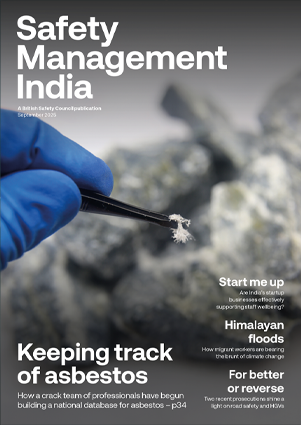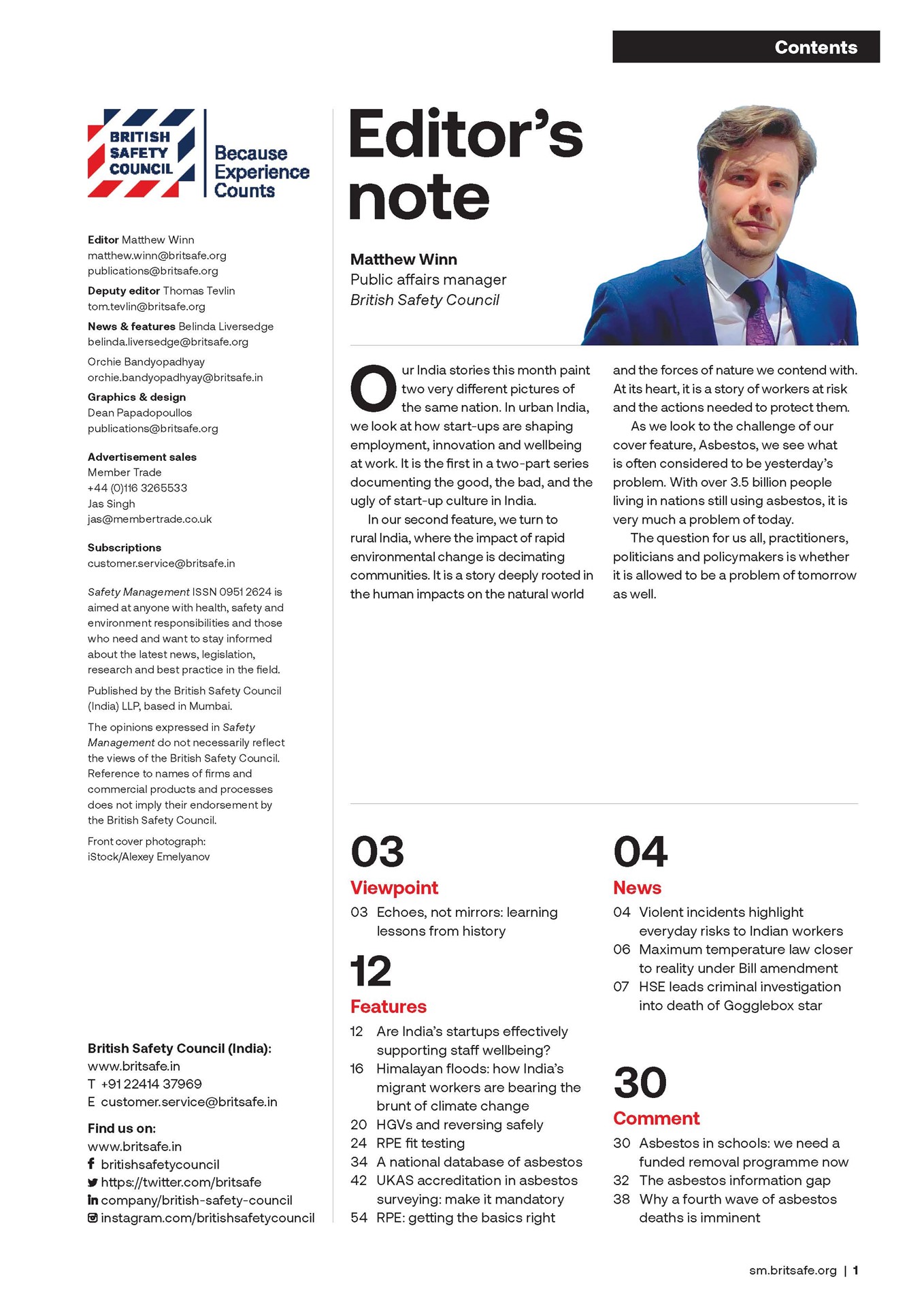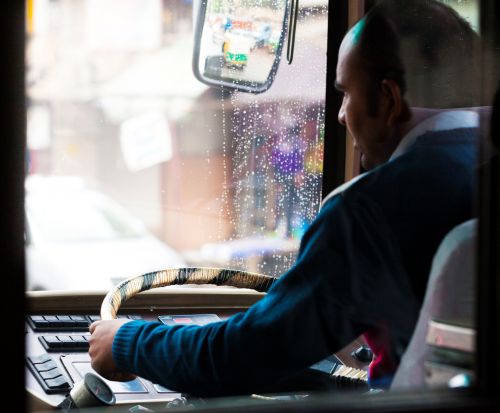Artificial intelligence has the potential to significantly enhance the management of occupational safety by analysing vast amounts of both internal and external industry safety data. This data can be continuously updated, integrating lessons learned to support real-time improvements in worker safety.
Features
Can AI be trusted with worker safety?
Artificial Intelligence (AI) has rapidly become an indispensable tool across many industries, leaving no area untouched, including worker safety.
One of the most recent areas where AI has started to make an impact is in worker safety. But what type of functions for worker safety can AI deliver, and in this highly regulated area, is this something we can trust?
‘Control of Work’ has come a long way since its inception following the fatal incidents of the past, especially with the advent of Industry 4.0. The push to take up new technologies by most companies is now seen as a must-do.
The benefits of technology speak for themselves, and control of work and worker safety is no exception. Ensuring efficiencies, improved communication, real-time data and – most importantly – safety, it is inevitable that AI will become a part of worker safety moving forward. But how, when, and the big question – as mentioned above - is it something that can be trusted?
 A key benefit of AI is that it constantly learns. Photograph: iStock
A key benefit of AI is that it constantly learns. Photograph: iStock
With AI being the latest trend, most suppliers will say they have some form of solution. However, a truth to bear in mind is that not all AI’s are created equal.
You need a solution that helps ensure worker safety, but also one that you can trust. The element of trust is a big area of discussion within the AI solutions environment. Let’s face it, the whole concept and the speed of development within AI can be scary, to say the least. To truly keep workers safe, the AI used has to follow regulations and positively help as a function.
The repercussions of AI getting it wrong when it comes to workers’ lives is simply not an option.
Along with readily available Control of Work software, AI, with its capacity to process vast data sets, recognise patterns and offer suggestions for best practice, can potentially offer an important addition to a safer, smarter and more proactive work environment. This is particularly true when it is married with already established traditional control of work technologies.
With AI development being so fast paced, regulations and protocols are continually being updated. Key in the UK is Cyber Essentials Plus, which is a more rigorous version of the UK Government’s Cyber Essentials scheme, requiring an independent technical audit of an organisation’s IT infrastructure to verify the effectiveness of security controls.
Aside from this, the basic guidance the UK government has used to date is a ‘Principles-Based Approach’. In order to allow for flexibility and adaptation as AI technologies evolve, the framework relies on general principles rather than detailed prescriptive rules.
This framework has five key principles, which are:
- Safety, security and robustness: ensuring AI systems are safe, secure, and reliable.
- Appropriate transparency and explainability: making AI systems understandable and accountable.
- Fairness: preventing AI systems from perpetuating bias or discrimination.
- Accountability and governance: establishing clear lines of responsibility and oversight.
- Contestability and redress: providing mechanisms for individuals to challenge or seek remedy for AI-related harms.
Any AI selected must adopt these principles to ensure the continued safety and relevance of data.
So, how can AI potentially be used for worker safety?
Every year, millions of workers suffer from workplace injuries, many of which are preventable. According to the International Labour Organization (ILO), over 2.78 million work-related deaths occur annually, alongside hundreds of millions of non-fatal accidents and illnesses. These incidents carry a heavy human cost and result in significant financial losses for businesses due to medical expenses, lost productivity, legal liabilities and increased insurance premiums.
 Through predictive analytics, real-time monitoring, robotics and personalised wearables, AI can help organisations to protect their most valuable asset – their people. Photograph: iStock
Through predictive analytics, real-time monitoring, robotics and personalised wearables, AI can help organisations to protect their most valuable asset – their people. Photograph: iStock
Industries such as construction, manufacturing, mining, oil and gas and transportation are particularly vulnerable due to the physical nature of the work and exposure to hazardous environments.
Any technology that can help alleviate the statistics above is of utmost value to companies that have a workforce to protect. So, how can AI help?
AI excels at analysing vast amounts of historical and real-time data. If you could feed those documents into an AI-driven solution that would analyse them quickly and offer you not just a score of quality but also provide you with a best practice safety suggestions report based on current knowledge afterwards, it would no doubt be of benefit.
Now imagine sharing that information with all stakeholders through a real-time dashboard outlining the powerful insights to the scoring, recommended improvements and quality? Not just for one company, but all parties and contractors involved.
Dependant on what industry you are in and what hazard level you work at, you will have a number of different procedures, policies and approaches to risk assessment and method statements (known as RAMS). With this in mind, especially in the context of multiple contractors on-site, the volume of information to be checked and confirmed can be daunting, leaving little time to review and update for current best practice and lessons learned.
In addition to this, imagine the above functionality embedded into a control of work software solution, offering in-depth worker safety practices for all levels of hazard and risk. Giving both full-time workers and contractors access to best practice risk assessments, whoever they are, whatever industry they are in, and whatever task they are faced with.
AI accuracy
Another benefit of AI is that it constantly learns; however, the sources being learnt from are critical to accuracy. We have all heard examples of popular AI making up sources as references for information. In addition, an AI pointed at the internet, as a whole, risks learning from bad data and spurious information. Indeed, these generic AI solutions are often less than 40 per cent accurate. Which is why they are not normally accepted in highly regulated health and safety environments.
More capable AI solutions are generally set to access specific areas of good and relevant data sources.
This is an extremely important area to ensure continuous improvement in control of work and worker safety. Validated lessons learnt can be uploaded into the system, reviewed and then measures provided to enable teams to make amends to processes and policies to avoid repeating the same mistakes in the future. This data can be built upon from multiple industries, ensuring significantly improved mitigation and efficiencies for workforces and contractors.
 The use of AI, especially in monitoring and surveillance, raises concerns about employee privacy. Photograph: iStock
The use of AI, especially in monitoring and surveillance, raises concerns about employee privacy. Photograph: iStock
With good data and reliable data sources, it is possible for an AI to achieve greater than 90 per cent accuracy. This, in turn, enables users to have the confidence to trust any recommendations given, hence allowing companies to significantly benefit from the AI’s abilities and speed in the context of control of work and worker safety.
What does the future hold?
With AI technology developing at such a rapid pace, companies have the advantage of accessing their historical data, information and instructions in ways that could never be achieved without the support of AI, simply because of the speed at which AI models can process and learn from data and other types of information.
We are already talking about what a ‘future worker’ will look like in a more autonomous world. With the right development and technology from trusted companies, technology will very much help and keep workers safe instead of the feared view of automation getting it wrong.
Wearables technology
Wearable devices enhanced by AI can provide continuous monitoring of worker health and safety metrics, body temperature, fatigue levels and posture as well as worker location. These devices can be integrated with AI systems that assess the risk of injury or illness based on physiological or location-based indicators.
For example, smart helmets and vests equipped with sensors can track exposure to harmful gases, noise levels or temperature extremes. In physically demanding jobs, wearables can monitor for signs of overexertion or dehydration, alerting both the worker and management before a serious health event occurs.
Additionally, by tying in exclusion zones and geofencing, workers can receive a warning if they enter any areas considered as high risk or dangerous.
Robotics and connectivity
AI-driven robots can perform high-risk tasks that would otherwise endanger human workers. In industries such as refining, petrochemical or mining, autonomous robots can be deployed in hazardous zones to conduct inspections, maintenance or material handling. This reduces human exposure to dangerous conditions.
Collaborative robots can also enhance safety in shared workspaces by being able to adjust their movements based on human proximity. AI enables these robots to operate alongside workers without causing harm, by learning from interactions and adapting to unpredictable human behaviour.
5G connectivity will facilitate faster data transmission, enabling more sophisticated AI applications in remote or mobile work environments. AI-human collaboration will become the norm, with AI systems augmenting human judgment rather than replacing it by allowing humans to focus on anomalies and a broader plant perspective.
Challenges and considerations
While AI offers significant promise, its implementation will not be without challenges:
- Data privacy and ethics
The use of AI, especially in monitoring and surveillance, raises concerns about employee privacy. Wearables and computer vision systems can be perceived as intrusive if not implemented transparently. Employers must balance safety with ethical considerations, ensuring data is anonymised, securely stored and only used for legitimate safety purposes. - Workforce adaptation
AI adoption can trigger resistance among workers who fear job displacement or are unfamiliar with new technologies. It is crucial to involve employees in the implementation process, provide adequate training and emphasise the role of AI as a support tool rather than a replacement. - Reliability and bias
An AI system’s intelligence and accuracy are directly shaped by the data used to train it – meaning poor data leads to poor outcomes. Regular validation and calibration are essential to ensure AI models remain accurate and reliable.
Benefits
With the above in mind, by embracing AI and established worker safety technology, companies will be able to improve safety outcomes and foster a culture of innovation and responsibility that can offer many advantages, including:
- Proactive risk mitigation: instead of reacting to incidents after they occur, AI can enable organisations to anticipate and prevent them
- Improved decision-making: AI analyses complex datasets and offers evidence-based recommendations, reducing human error in safety management
- Real-time response: instant alerts and automated interventions can enhance response times
- Compliance and documentation: AI can simplify regulatory compliance by automatically tracking regulatory updates.
Conclusion
Looking ahead, AI’s role in worker safety will continue to evolve and expand by transforming approaches into proactive, data-driven systems. Through predictive analytics, real-time monitoring, robotics and personalised wearables, AI can help organisations to protect their most valuable asset – their people. While challenges such as privacy concerns and integration hurdles remain, the potential benefits far outweigh the obstacles.
However, the choice of AI will have a significant impact on accuracy and trustworthiness, so it is critical to ensure that due consideration is given in the selection of the best AI tool or solution to meet the business’s needs.
By embracing a trusted AI, companies will potentially improve safety outcomes and foster a culture of positive innovation. As technology continues to evolve, the future of worker safety looks not just smarter, but safer.
For more information see:
yokogawa.com
linkedin.com/company/Yokogawa
@Yokogawa
Emma Bundy is Head of marketing at Yokogawa RAP


FEATURES

Delhi’s air pollution problem leaves construction workers jobless and without pay
By Orchie Bandyopadhyay on 10 November 2025
Every autumn and winter, Delhi experiences terrible air pollution that places the health of its 40 million residents at grave risk. But government measures to alleviate the problem by temporarily closing construction sites mean hundreds of thousands of daily-wage labourers are being left without wages and a means of financial support.

India’s road rage crisis: how professional drivers are bearing the brunt
By Orchie Bandyopadhyay on 10 November 2025
High profile reports of violent attacks on people who drive for work purposes, like bus and delivery drivers, have shone a spotlight on the growing problem of road rage in India. Commentators say it is now time for the Government to step up prosecutions of those who act aggressively on the road, while educating drivers on stress management techniques, to tackle the problem.

